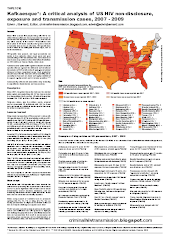Africa’s HIV transmission laws based on questionable science
by Cassandra Willyard, New York
Nature Medicine 13, 890 (2007)
Published online: 31 August 2007
Faced with an AIDS epidemic that kills millions every year, countries in sub-Saharan Africa are contemplating a new prevention strategy: criminal charges.
Uganda, touted as the rare success story in the region, is the latest nation to propose a law that would criminalize knowingly transmitting HIV to another person, the country’s health minister announced in June. Since 2001, Zimbabwe, Lesotho and Swaziland have also adopted similar laws.
Few say the laws do what they’re intended to: reduce the spread of HIV. “They make lawmakers feel good, but they have very limited positive benefits for the public,” says Jonathan Berger, head of policy and research at the Johannesburg-based AIDS Law Project.
Apart from stigmatizing the disease more than it already is, critics warn, the laws ignore the fact that these countries may not have the resources to perform the careful genetic analysis required to distinguish the innocent from the guilty.
Phylogenetic analysis helps pinpoint how closely related two isolates of HIV are. In a criminal case, a virologist would obtain genetic sequences of the virus from both parties involved and compare them to sequences in a database, such as the US National Institutes of Health’s GenBank, or from other infected individuals in the community.
If the viruses appear more closely related to each other than they are to samples taken from the larger population, it increases the likelihood that one person infected the other.
The procedure has its limitations, however. “It doesn’t say anything about the direction of movement. It doesn’t say anything about timing. It doesn’t even really say that the transmission took place between the two people,” says Yusef Azad, director of policy and campaigns at the National AIDS Trust, a UK-based advocacy group. “They both could have been infected by a third party.”
Still, phylogenetics can exonerate the innocent. If the two HIV samples aren’t closely related, it’s unlikely one person could have infected the other. “The greatest power of it is exculpatory,” says Gerald Learn, a microbiologist at the University of Washington. “If I was a defense lawyer, I would insist on it.”
But the procedure is complicated and costly. “Scientists who are not trained in this field couldn’t just read published reports and try to do this on their own without having the proper tools,” says Michael Metzker, assistant professor of molecular genetics at the Baylor College of Medicine in Houston.
Genetic analysis of each HIV sample can require more than 100 sequences, with a price tag between $1 and $5 per sequence—no small sum in a developing country.
A few labs in Uganda are equipped to do the analyses, says Maria Wawer, a professor of population, family and reproductive health at Johns Hopkins University who conducts research in Uganda. “But it is likely to remain too expensive for the foreseeable future,” she says.
Courts in these countries may instead rely on circumstantial evidence, raising the risk of wrongful convictions.
“In the absence of really clear scientific evidence as to who infected whom,” says Azad, “there will too often be an assumption that those categorized as undesirable by society are guilty of infecting other people.”
In 2002, UNAIDS argued against laws that penalize HIV transmission, recommending instead that responsible individuals be prosecuted using standard criminal laws, notes Azad. “Any legislation which singles out HIV for this kind of criminal sanction is breaching international human rights guidelines.”
Friday, 31 August 2007
Africa’s HIV transmission laws based on questionable science
Posted by
Edwin J Bernard
on
31.8.07
Labels:
advocacy,
Africa,
HIV forensics,
Lesotho,
phylogenetics,
policy,
Swaziland,
Uganda,
Zimbabwe


Archive
Is this blog useful? Let me know
If you find this blog useful, please let me know, and if you find it really useful, please also consider making a small donation.
Thank you.
(Clicking on the Donate button above will take you to Paypal.)








0 comments:
Post a Comment